Leadership in the Digital Age: Self-Analysis Report
VerifiedAdded on 2022/12/30
|18
|5118
|46
Report
AI Summary
This report delves into the multifaceted realm of digital leadership, commencing with a self-analysis of leadership strengths and weaknesses, incorporating various leadership theories such as contingency, situational, behavioral, and trait theories. The report then transitions to exploring crucial leadership capabilities and behaviors vital for success in the retail industry's digital age, emphasizing agile leadership, forward-thinking abilities, risk-taking, and contextual intelligence. A significant portion is dedicated to business transformation, analyzing the impact of digital technologies on market share and profitability. Finally, the report culminates in a personal development plan, offering a roadmap for enhancing leadership skills and adapting to the evolving digital landscape. The report leverages illustrations and references to support its analysis, offering a practical guide for aspiring digital leaders.
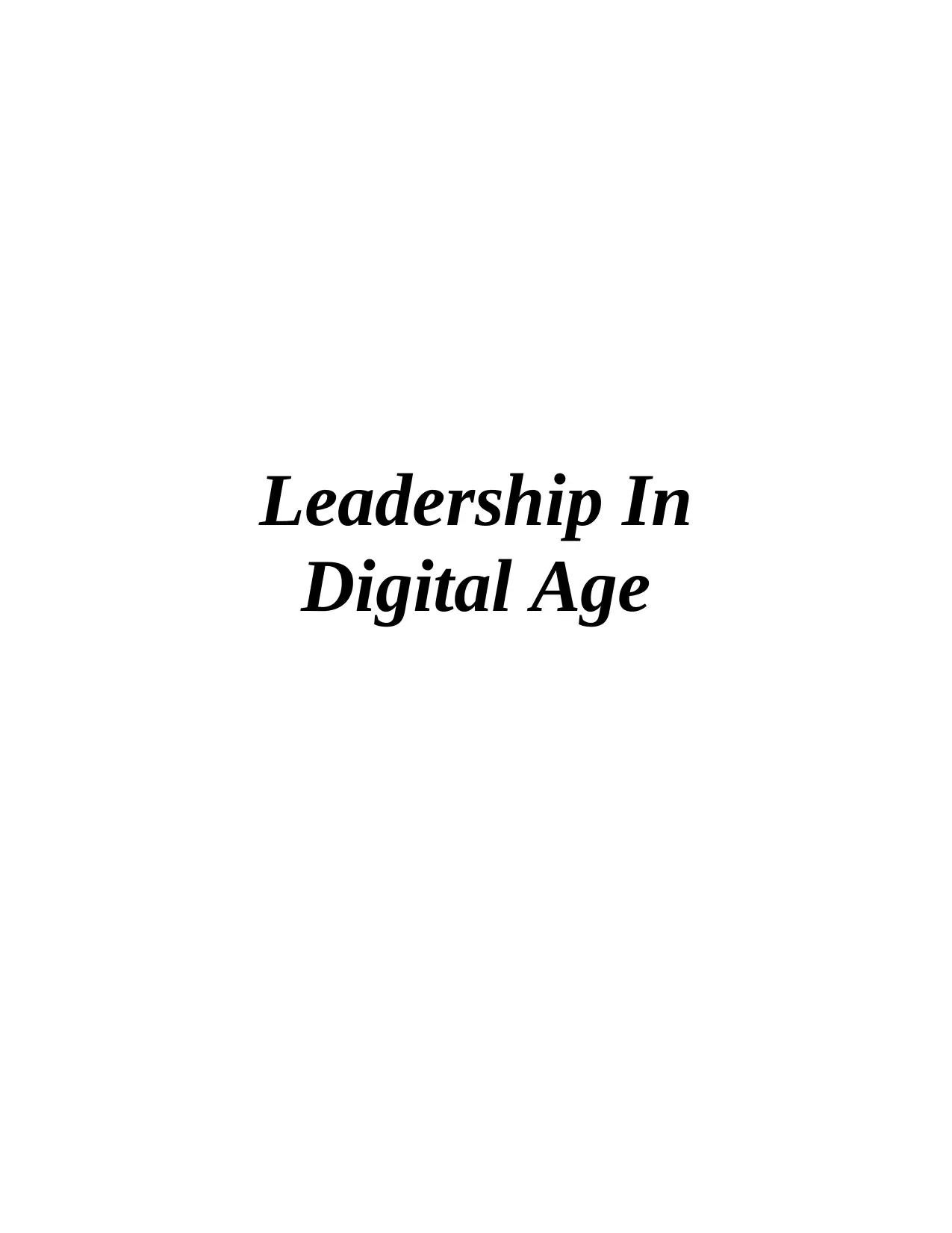
Leadership In
Digital Age
Digital Age
Paraphrase This Document
Need a fresh take? Get an instant paraphrase of this document with our AI Paraphraser
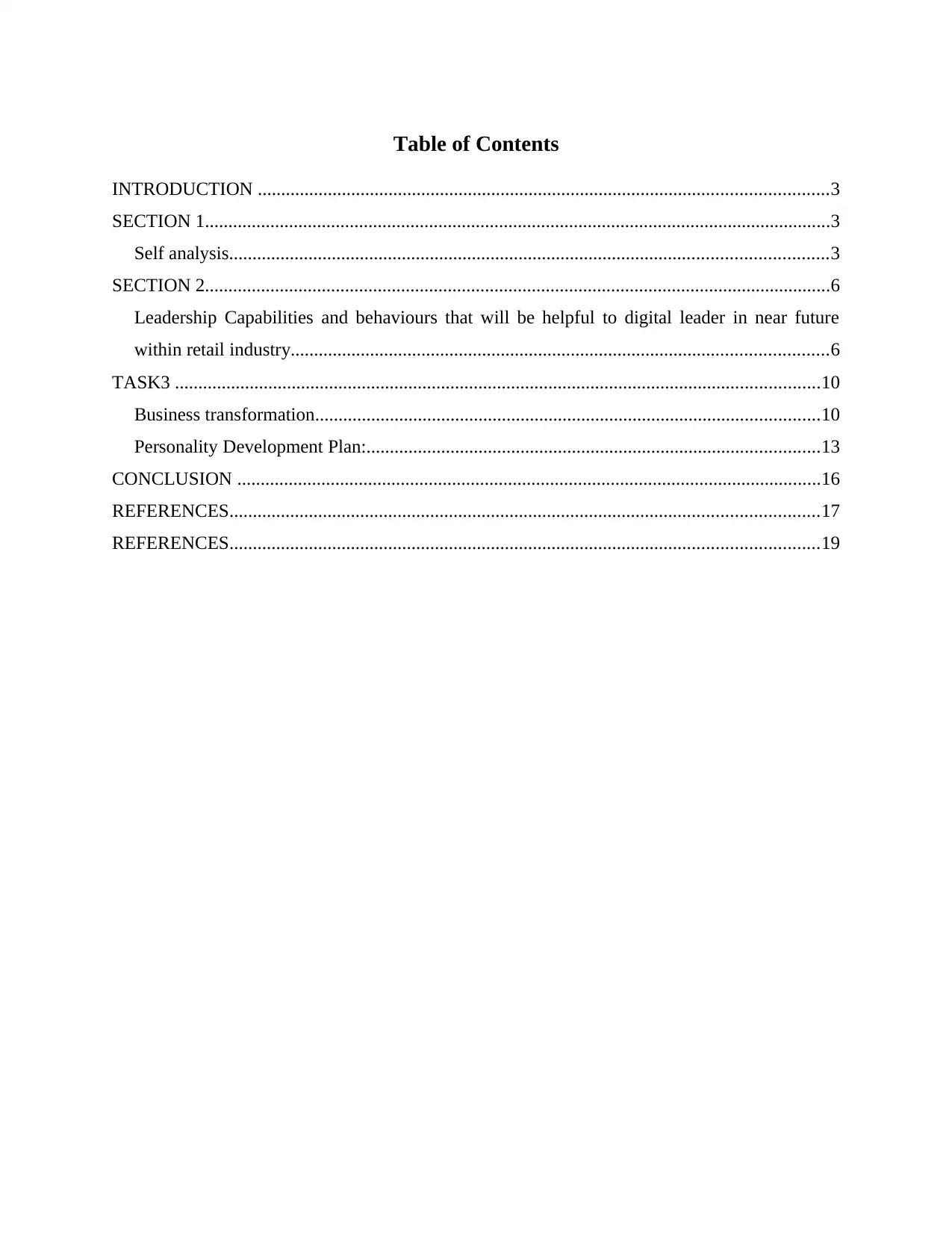
Table of Contents
INTRODUCTION ..........................................................................................................................3
SECTION 1......................................................................................................................................3
Self analysis................................................................................................................................3
SECTION 2......................................................................................................................................6
Leadership Capabilities and behaviours that will be helpful to digital leader in near future
within retail industry...................................................................................................................6
TASK3 ..........................................................................................................................................10
Business transformation............................................................................................................10
Personality Development Plan:.................................................................................................13
CONCLUSION .............................................................................................................................16
REFERENCES..............................................................................................................................17
REFERENCES..............................................................................................................................19
INTRODUCTION ..........................................................................................................................3
SECTION 1......................................................................................................................................3
Self analysis................................................................................................................................3
SECTION 2......................................................................................................................................6
Leadership Capabilities and behaviours that will be helpful to digital leader in near future
within retail industry...................................................................................................................6
TASK3 ..........................................................................................................................................10
Business transformation............................................................................................................10
Personality Development Plan:.................................................................................................13
CONCLUSION .............................................................................................................................16
REFERENCES..............................................................................................................................17
REFERENCES..............................................................................................................................19
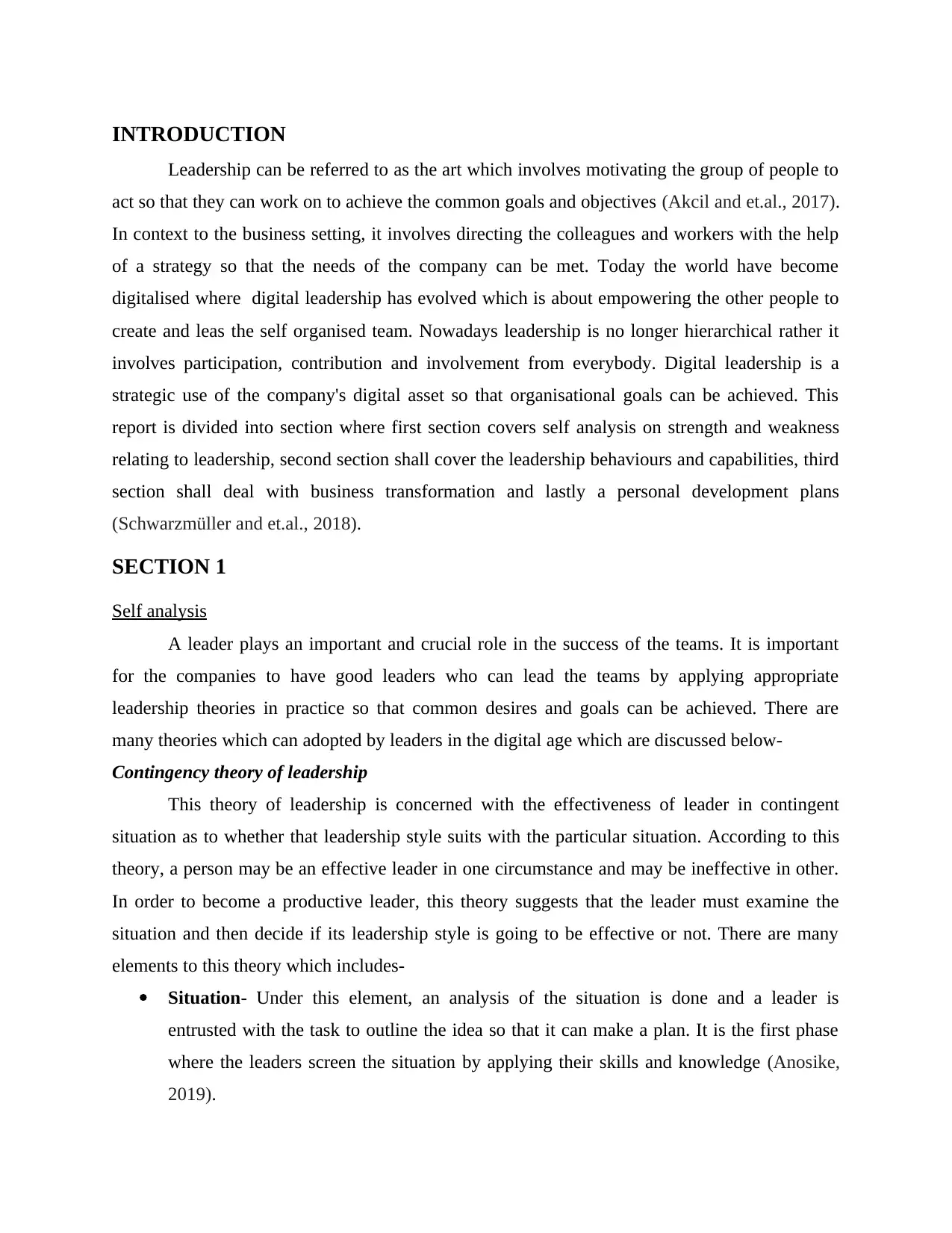
INTRODUCTION
Leadership can be referred to as the art which involves motivating the group of people to
act so that they can work on to achieve the common goals and objectives (Akcil and et.al., 2017).
In context to the business setting, it involves directing the colleagues and workers with the help
of a strategy so that the needs of the company can be met. Today the world have become
digitalised where digital leadership has evolved which is about empowering the other people to
create and leas the self organised team. Nowadays leadership is no longer hierarchical rather it
involves participation, contribution and involvement from everybody. Digital leadership is a
strategic use of the company's digital asset so that organisational goals can be achieved. This
report is divided into section where first section covers self analysis on strength and weakness
relating to leadership, second section shall cover the leadership behaviours and capabilities, third
section shall deal with business transformation and lastly a personal development plans
(Schwarzmüller and et.al., 2018).
SECTION 1
Self analysis
A leader plays an important and crucial role in the success of the teams. It is important
for the companies to have good leaders who can lead the teams by applying appropriate
leadership theories in practice so that common desires and goals can be achieved. There are
many theories which can adopted by leaders in the digital age which are discussed below-
Contingency theory of leadership
This theory of leadership is concerned with the effectiveness of leader in contingent
situation as to whether that leadership style suits with the particular situation. According to this
theory, a person may be an effective leader in one circumstance and may be ineffective in other.
In order to become a productive leader, this theory suggests that the leader must examine the
situation and then decide if its leadership style is going to be effective or not. There are many
elements to this theory which includes-
Situation- Under this element, an analysis of the situation is done and a leader is
entrusted with the task to outline the idea so that it can make a plan. It is the first phase
where the leaders screen the situation by applying their skills and knowledge (Anosike,
2019).
Leadership can be referred to as the art which involves motivating the group of people to
act so that they can work on to achieve the common goals and objectives (Akcil and et.al., 2017).
In context to the business setting, it involves directing the colleagues and workers with the help
of a strategy so that the needs of the company can be met. Today the world have become
digitalised where digital leadership has evolved which is about empowering the other people to
create and leas the self organised team. Nowadays leadership is no longer hierarchical rather it
involves participation, contribution and involvement from everybody. Digital leadership is a
strategic use of the company's digital asset so that organisational goals can be achieved. This
report is divided into section where first section covers self analysis on strength and weakness
relating to leadership, second section shall cover the leadership behaviours and capabilities, third
section shall deal with business transformation and lastly a personal development plans
(Schwarzmüller and et.al., 2018).
SECTION 1
Self analysis
A leader plays an important and crucial role in the success of the teams. It is important
for the companies to have good leaders who can lead the teams by applying appropriate
leadership theories in practice so that common desires and goals can be achieved. There are
many theories which can adopted by leaders in the digital age which are discussed below-
Contingency theory of leadership
This theory of leadership is concerned with the effectiveness of leader in contingent
situation as to whether that leadership style suits with the particular situation. According to this
theory, a person may be an effective leader in one circumstance and may be ineffective in other.
In order to become a productive leader, this theory suggests that the leader must examine the
situation and then decide if its leadership style is going to be effective or not. There are many
elements to this theory which includes-
Situation- Under this element, an analysis of the situation is done and a leader is
entrusted with the task to outline the idea so that it can make a plan. It is the first phase
where the leaders screen the situation by applying their skills and knowledge (Anosike,
2019).
⊘ This is a preview!⊘
Do you want full access?
Subscribe today to unlock all pages.

Trusted by 1+ million students worldwide
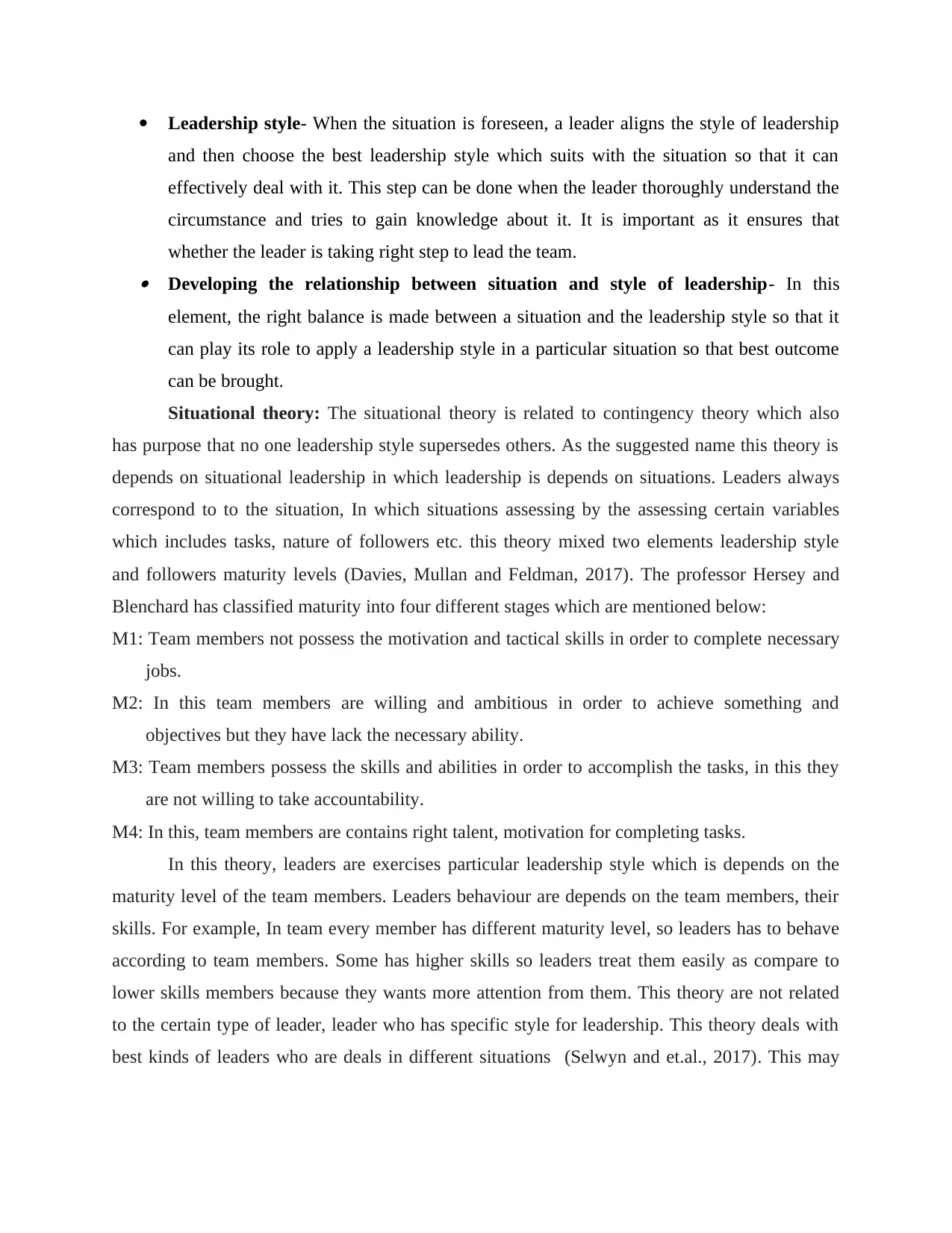
Leadership style- When the situation is foreseen, a leader aligns the style of leadership
and then choose the best leadership style which suits with the situation so that it can
effectively deal with it. This step can be done when the leader thoroughly understand the
circumstance and tries to gain knowledge about it. It is important as it ensures that
whether the leader is taking right step to lead the team. Developing the relationship between situation and style of leadership- In this
element, the right balance is made between a situation and the leadership style so that it
can play its role to apply a leadership style in a particular situation so that best outcome
can be brought.
Situational theory: The situational theory is related to contingency theory which also
has purpose that no one leadership style supersedes others. As the suggested name this theory is
depends on situational leadership in which leadership is depends on situations. Leaders always
correspond to to the situation, In which situations assessing by the assessing certain variables
which includes tasks, nature of followers etc. this theory mixed two elements leadership style
and followers maturity levels (Davies, Mullan and Feldman, 2017). The professor Hersey and
Blenchard has classified maturity into four different stages which are mentioned below:
M1: Team members not possess the motivation and tactical skills in order to complete necessary
jobs.
M2: In this team members are willing and ambitious in order to achieve something and
objectives but they have lack the necessary ability.
M3: Team members possess the skills and abilities in order to accomplish the tasks, in this they
are not willing to take accountability.
M4: In this, team members are contains right talent, motivation for completing tasks.
In this theory, leaders are exercises particular leadership style which is depends on the
maturity level of the team members. Leaders behaviour are depends on the team members, their
skills. For example, In team every member has different maturity level, so leaders has to behave
according to team members. Some has higher skills so leaders treat them easily as compare to
lower skills members because they wants more attention from them. This theory are not related
to the certain type of leader, leader who has specific style for leadership. This theory deals with
best kinds of leaders who are deals in different situations (Selwyn and et.al., 2017). This may
and then choose the best leadership style which suits with the situation so that it can
effectively deal with it. This step can be done when the leader thoroughly understand the
circumstance and tries to gain knowledge about it. It is important as it ensures that
whether the leader is taking right step to lead the team. Developing the relationship between situation and style of leadership- In this
element, the right balance is made between a situation and the leadership style so that it
can play its role to apply a leadership style in a particular situation so that best outcome
can be brought.
Situational theory: The situational theory is related to contingency theory which also
has purpose that no one leadership style supersedes others. As the suggested name this theory is
depends on situational leadership in which leadership is depends on situations. Leaders always
correspond to to the situation, In which situations assessing by the assessing certain variables
which includes tasks, nature of followers etc. this theory mixed two elements leadership style
and followers maturity levels (Davies, Mullan and Feldman, 2017). The professor Hersey and
Blenchard has classified maturity into four different stages which are mentioned below:
M1: Team members not possess the motivation and tactical skills in order to complete necessary
jobs.
M2: In this team members are willing and ambitious in order to achieve something and
objectives but they have lack the necessary ability.
M3: Team members possess the skills and abilities in order to accomplish the tasks, in this they
are not willing to take accountability.
M4: In this, team members are contains right talent, motivation for completing tasks.
In this theory, leaders are exercises particular leadership style which is depends on the
maturity level of the team members. Leaders behaviour are depends on the team members, their
skills. For example, In team every member has different maturity level, so leaders has to behave
according to team members. Some has higher skills so leaders treat them easily as compare to
lower skills members because they wants more attention from them. This theory are not related
to the certain type of leader, leader who has specific style for leadership. This theory deals with
best kinds of leaders who are deals in different situations (Selwyn and et.al., 2017). This may
Paraphrase This Document
Need a fresh take? Get an instant paraphrase of this document with our AI Paraphraser
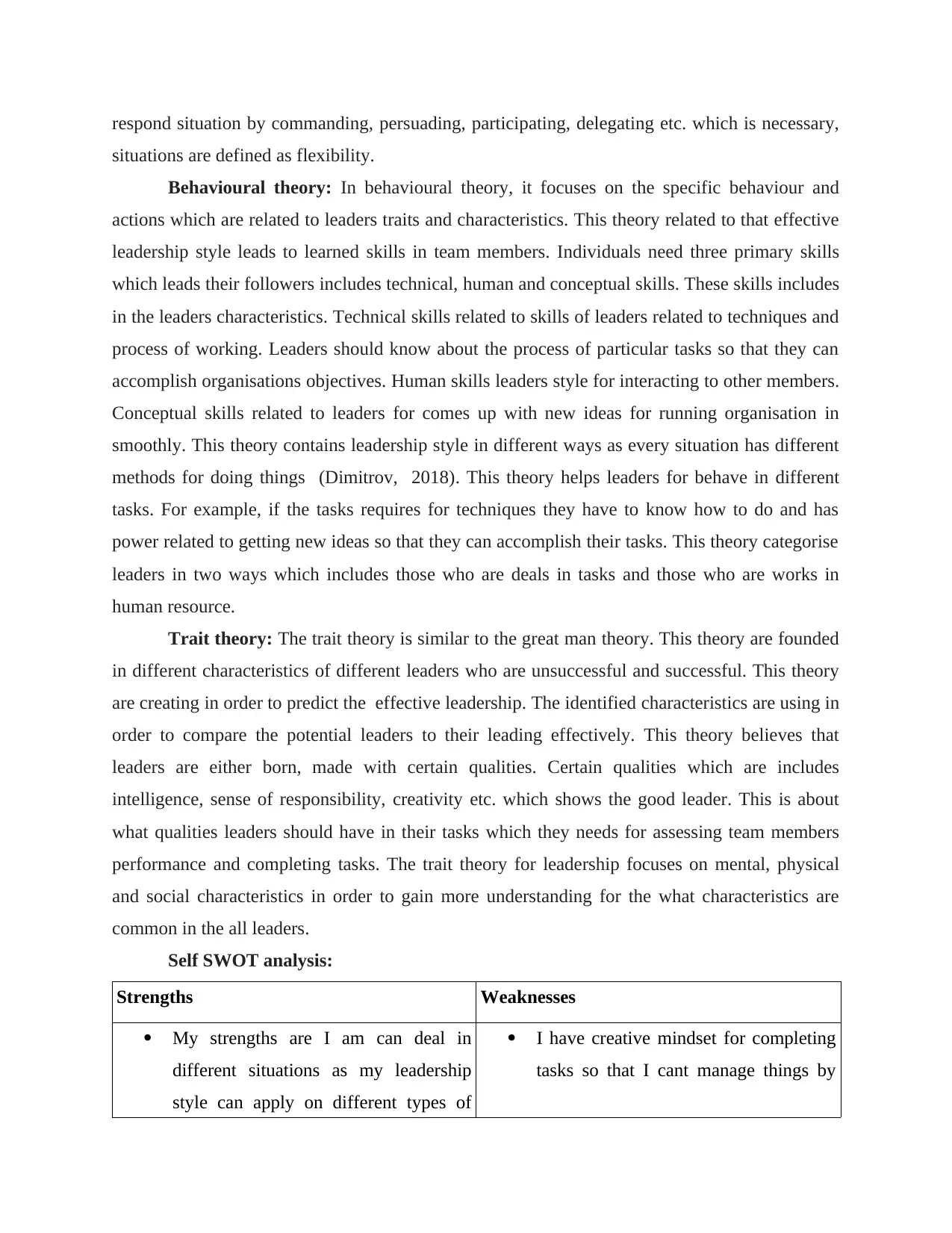
respond situation by commanding, persuading, participating, delegating etc. which is necessary,
situations are defined as flexibility.
Behavioural theory: In behavioural theory, it focuses on the specific behaviour and
actions which are related to leaders traits and characteristics. This theory related to that effective
leadership style leads to learned skills in team members. Individuals need three primary skills
which leads their followers includes technical, human and conceptual skills. These skills includes
in the leaders characteristics. Technical skills related to skills of leaders related to techniques and
process of working. Leaders should know about the process of particular tasks so that they can
accomplish organisations objectives. Human skills leaders style for interacting to other members.
Conceptual skills related to leaders for comes up with new ideas for running organisation in
smoothly. This theory contains leadership style in different ways as every situation has different
methods for doing things (Dimitrov, 2018). This theory helps leaders for behave in different
tasks. For example, if the tasks requires for techniques they have to know how to do and has
power related to getting new ideas so that they can accomplish their tasks. This theory categorise
leaders in two ways which includes those who are deals in tasks and those who are works in
human resource.
Trait theory: The trait theory is similar to the great man theory. This theory are founded
in different characteristics of different leaders who are unsuccessful and successful. This theory
are creating in order to predict the effective leadership. The identified characteristics are using in
order to compare the potential leaders to their leading effectively. This theory believes that
leaders are either born, made with certain qualities. Certain qualities which are includes
intelligence, sense of responsibility, creativity etc. which shows the good leader. This is about
what qualities leaders should have in their tasks which they needs for assessing team members
performance and completing tasks. The trait theory for leadership focuses on mental, physical
and social characteristics in order to gain more understanding for the what characteristics are
common in the all leaders.
Self SWOT analysis:
Strengths Weaknesses
My strengths are I am can deal in
different situations as my leadership
style can apply on different types of
I have creative mindset for completing
tasks so that I cant manage things by
situations are defined as flexibility.
Behavioural theory: In behavioural theory, it focuses on the specific behaviour and
actions which are related to leaders traits and characteristics. This theory related to that effective
leadership style leads to learned skills in team members. Individuals need three primary skills
which leads their followers includes technical, human and conceptual skills. These skills includes
in the leaders characteristics. Technical skills related to skills of leaders related to techniques and
process of working. Leaders should know about the process of particular tasks so that they can
accomplish organisations objectives. Human skills leaders style for interacting to other members.
Conceptual skills related to leaders for comes up with new ideas for running organisation in
smoothly. This theory contains leadership style in different ways as every situation has different
methods for doing things (Dimitrov, 2018). This theory helps leaders for behave in different
tasks. For example, if the tasks requires for techniques they have to know how to do and has
power related to getting new ideas so that they can accomplish their tasks. This theory categorise
leaders in two ways which includes those who are deals in tasks and those who are works in
human resource.
Trait theory: The trait theory is similar to the great man theory. This theory are founded
in different characteristics of different leaders who are unsuccessful and successful. This theory
are creating in order to predict the effective leadership. The identified characteristics are using in
order to compare the potential leaders to their leading effectively. This theory believes that
leaders are either born, made with certain qualities. Certain qualities which are includes
intelligence, sense of responsibility, creativity etc. which shows the good leader. This is about
what qualities leaders should have in their tasks which they needs for assessing team members
performance and completing tasks. The trait theory for leadership focuses on mental, physical
and social characteristics in order to gain more understanding for the what characteristics are
common in the all leaders.
Self SWOT analysis:
Strengths Weaknesses
My strengths are I am can deal in
different situations as my leadership
style can apply on different types of
I have creative mindset for completing
tasks so that I cant manage things by
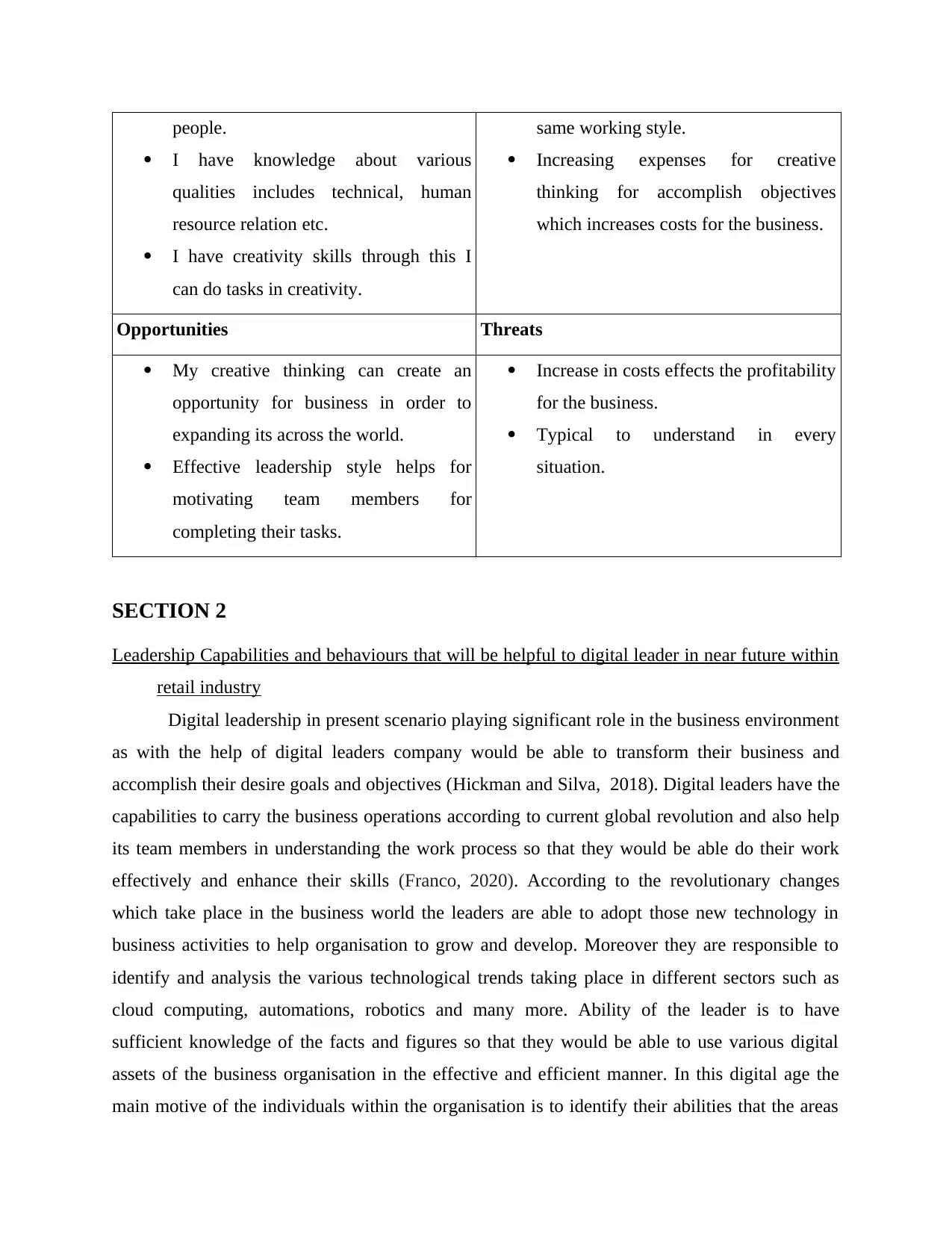
people.
I have knowledge about various
qualities includes technical, human
resource relation etc.
I have creativity skills through this I
can do tasks in creativity.
same working style.
Increasing expenses for creative
thinking for accomplish objectives
which increases costs for the business.
Opportunities Threats
My creative thinking can create an
opportunity for business in order to
expanding its across the world.
Effective leadership style helps for
motivating team members for
completing their tasks.
Increase in costs effects the profitability
for the business.
Typical to understand in every
situation.
SECTION 2
Leadership Capabilities and behaviours that will be helpful to digital leader in near future within
retail industry
Digital leadership in present scenario playing significant role in the business environment
as with the help of digital leaders company would be able to transform their business and
accomplish their desire goals and objectives (Hickman and Silva, 2018). Digital leaders have the
capabilities to carry the business operations according to current global revolution and also help
its team members in understanding the work process so that they would be able do their work
effectively and enhance their skills (Franco, 2020). According to the revolutionary changes
which take place in the business world the leaders are able to adopt those new technology in
business activities to help organisation to grow and develop. Moreover they are responsible to
identify and analysis the various technological trends taking place in different sectors such as
cloud computing, automations, robotics and many more. Ability of the leader is to have
sufficient knowledge of the facts and figures so that they would be able to use various digital
assets of the business organisation in the effective and efficient manner. In this digital age the
main motive of the individuals within the organisation is to identify their abilities that the areas
I have knowledge about various
qualities includes technical, human
resource relation etc.
I have creativity skills through this I
can do tasks in creativity.
same working style.
Increasing expenses for creative
thinking for accomplish objectives
which increases costs for the business.
Opportunities Threats
My creative thinking can create an
opportunity for business in order to
expanding its across the world.
Effective leadership style helps for
motivating team members for
completing their tasks.
Increase in costs effects the profitability
for the business.
Typical to understand in every
situation.
SECTION 2
Leadership Capabilities and behaviours that will be helpful to digital leader in near future within
retail industry
Digital leadership in present scenario playing significant role in the business environment
as with the help of digital leaders company would be able to transform their business and
accomplish their desire goals and objectives (Hickman and Silva, 2018). Digital leaders have the
capabilities to carry the business operations according to current global revolution and also help
its team members in understanding the work process so that they would be able do their work
effectively and enhance their skills (Franco, 2020). According to the revolutionary changes
which take place in the business world the leaders are able to adopt those new technology in
business activities to help organisation to grow and develop. Moreover they are responsible to
identify and analysis the various technological trends taking place in different sectors such as
cloud computing, automations, robotics and many more. Ability of the leader is to have
sufficient knowledge of the facts and figures so that they would be able to use various digital
assets of the business organisation in the effective and efficient manner. In this digital age the
main motive of the individuals within the organisation is to identify their abilities that the areas
⊘ This is a preview!⊘
Do you want full access?
Subscribe today to unlock all pages.

Trusted by 1+ million students worldwide
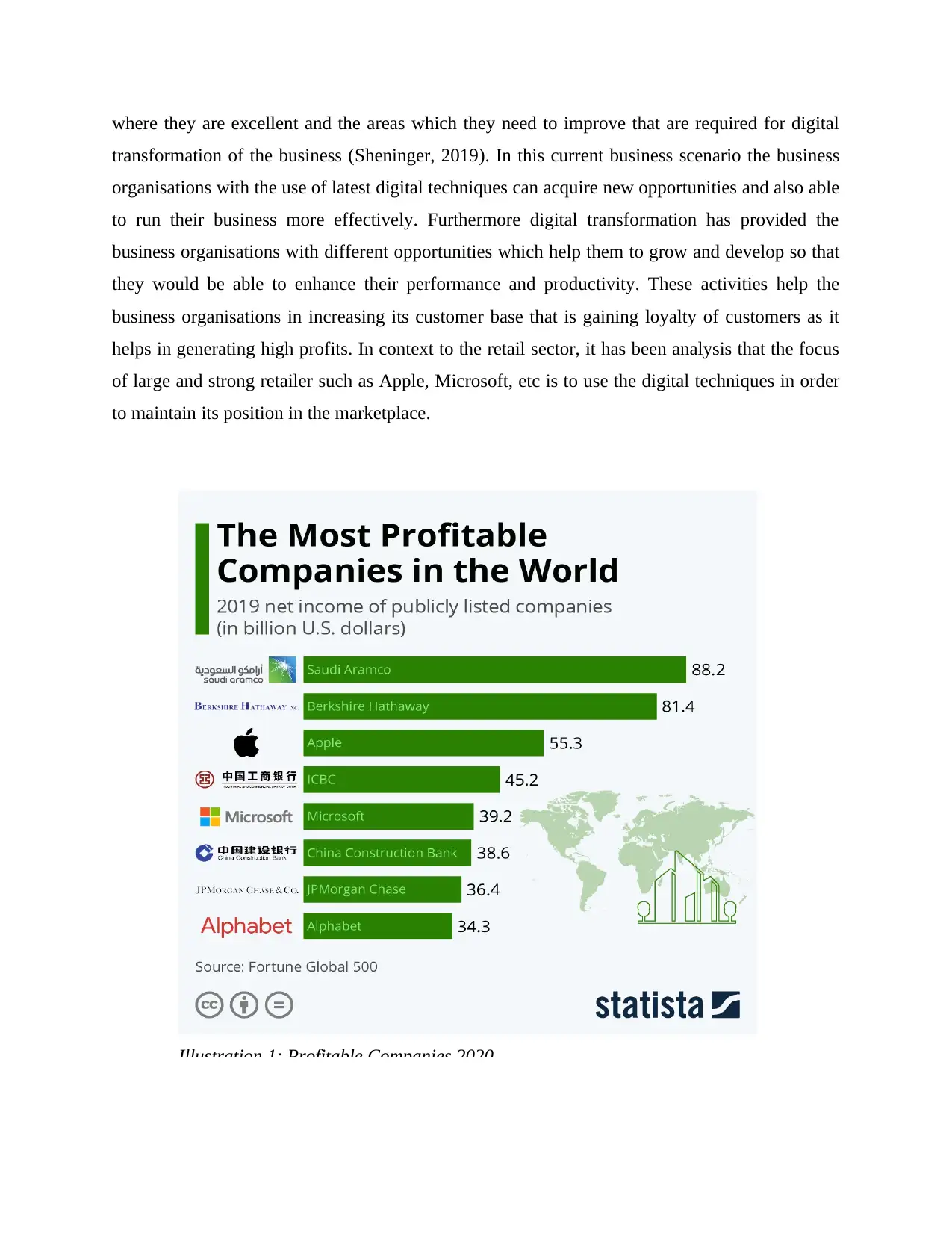
where they are excellent and the areas which they need to improve that are required for digital
transformation of the business (Sheninger, 2019). In this current business scenario the business
organisations with the use of latest digital techniques can acquire new opportunities and also able
to run their business more effectively. Furthermore digital transformation has provided the
business organisations with different opportunities which help them to grow and develop so that
they would be able to enhance their performance and productivity. These activities help the
business organisations in increasing its customer base that is gaining loyalty of customers as it
helps in generating high profits. In context to the retail sector, it has been analysis that the focus
of large and strong retailer such as Apple, Microsoft, etc is to use the digital techniques in order
to maintain its position in the marketplace.
Illustration 1: Profitable Companies 2020
transformation of the business (Sheninger, 2019). In this current business scenario the business
organisations with the use of latest digital techniques can acquire new opportunities and also able
to run their business more effectively. Furthermore digital transformation has provided the
business organisations with different opportunities which help them to grow and develop so that
they would be able to enhance their performance and productivity. These activities help the
business organisations in increasing its customer base that is gaining loyalty of customers as it
helps in generating high profits. In context to the retail sector, it has been analysis that the focus
of large and strong retailer such as Apple, Microsoft, etc is to use the digital techniques in order
to maintain its position in the marketplace.
Illustration 1: Profitable Companies 2020
Paraphrase This Document
Need a fresh take? Get an instant paraphrase of this document with our AI Paraphraser
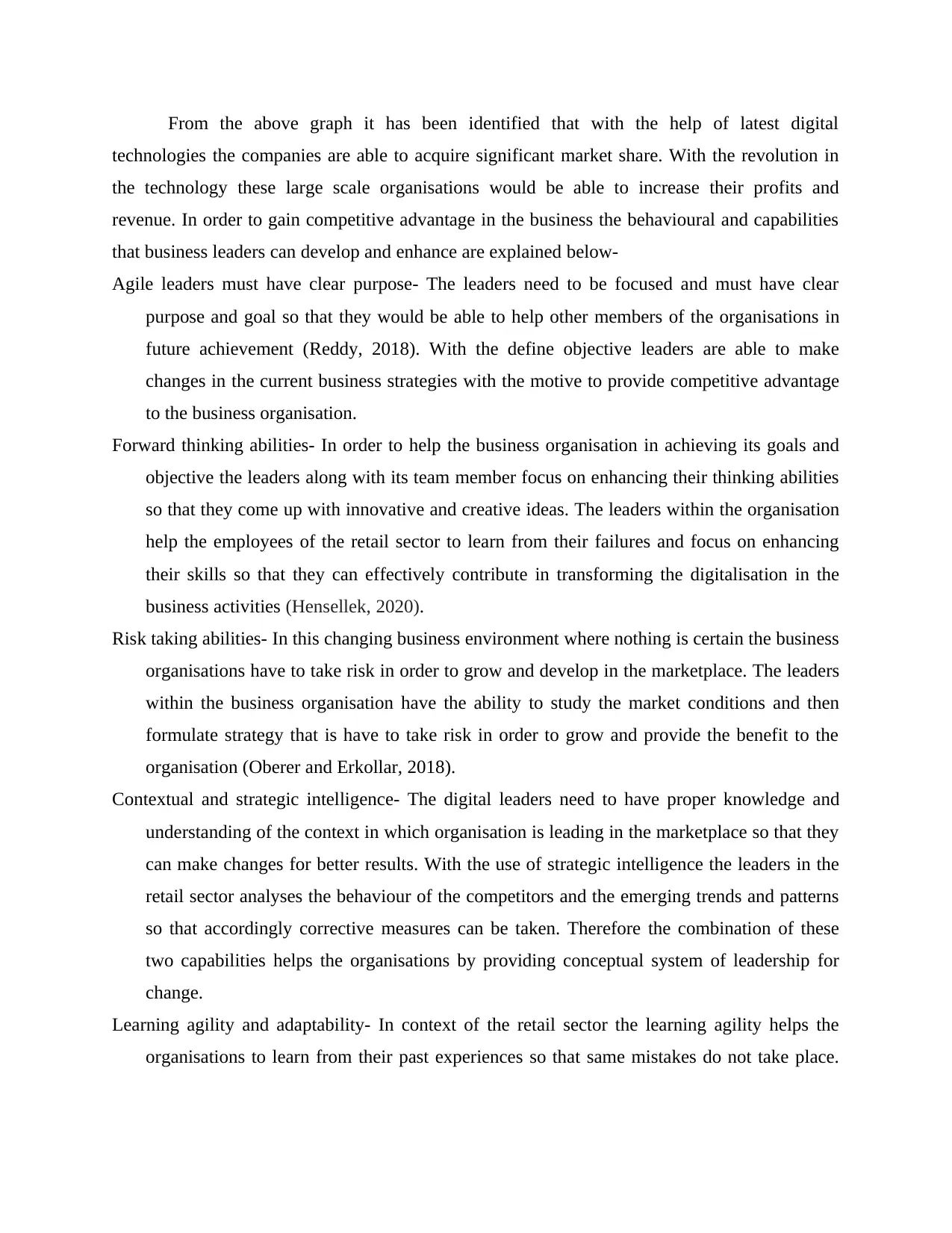
From the above graph it has been identified that with the help of latest digital
technologies the companies are able to acquire significant market share. With the revolution in
the technology these large scale organisations would be able to increase their profits and
revenue. In order to gain competitive advantage in the business the behavioural and capabilities
that business leaders can develop and enhance are explained below-
Agile leaders must have clear purpose- The leaders need to be focused and must have clear
purpose and goal so that they would be able to help other members of the organisations in
future achievement (Reddy, 2018). With the define objective leaders are able to make
changes in the current business strategies with the motive to provide competitive advantage
to the business organisation.
Forward thinking abilities- In order to help the business organisation in achieving its goals and
objective the leaders along with its team member focus on enhancing their thinking abilities
so that they come up with innovative and creative ideas. The leaders within the organisation
help the employees of the retail sector to learn from their failures and focus on enhancing
their skills so that they can effectively contribute in transforming the digitalisation in the
business activities (Hensellek, 2020).
Risk taking abilities- In this changing business environment where nothing is certain the business
organisations have to take risk in order to grow and develop in the marketplace. The leaders
within the business organisation have the ability to study the market conditions and then
formulate strategy that is have to take risk in order to grow and provide the benefit to the
organisation (Oberer and Erkollar, 2018).
Contextual and strategic intelligence- The digital leaders need to have proper knowledge and
understanding of the context in which organisation is leading in the marketplace so that they
can make changes for better results. With the use of strategic intelligence the leaders in the
retail sector analyses the behaviour of the competitors and the emerging trends and patterns
so that accordingly corrective measures can be taken. Therefore the combination of these
two capabilities helps the organisations by providing conceptual system of leadership for
change.
Learning agility and adaptability- In context of the retail sector the learning agility helps the
organisations to learn from their past experiences so that same mistakes do not take place.
technologies the companies are able to acquire significant market share. With the revolution in
the technology these large scale organisations would be able to increase their profits and
revenue. In order to gain competitive advantage in the business the behavioural and capabilities
that business leaders can develop and enhance are explained below-
Agile leaders must have clear purpose- The leaders need to be focused and must have clear
purpose and goal so that they would be able to help other members of the organisations in
future achievement (Reddy, 2018). With the define objective leaders are able to make
changes in the current business strategies with the motive to provide competitive advantage
to the business organisation.
Forward thinking abilities- In order to help the business organisation in achieving its goals and
objective the leaders along with its team member focus on enhancing their thinking abilities
so that they come up with innovative and creative ideas. The leaders within the organisation
help the employees of the retail sector to learn from their failures and focus on enhancing
their skills so that they can effectively contribute in transforming the digitalisation in the
business activities (Hensellek, 2020).
Risk taking abilities- In this changing business environment where nothing is certain the business
organisations have to take risk in order to grow and develop in the marketplace. The leaders
within the business organisation have the ability to study the market conditions and then
formulate strategy that is have to take risk in order to grow and provide the benefit to the
organisation (Oberer and Erkollar, 2018).
Contextual and strategic intelligence- The digital leaders need to have proper knowledge and
understanding of the context in which organisation is leading in the marketplace so that they
can make changes for better results. With the use of strategic intelligence the leaders in the
retail sector analyses the behaviour of the competitors and the emerging trends and patterns
so that accordingly corrective measures can be taken. Therefore the combination of these
two capabilities helps the organisations by providing conceptual system of leadership for
change.
Learning agility and adaptability- In context of the retail sector the learning agility helps the
organisations to learn from their past experiences so that same mistakes do not take place.
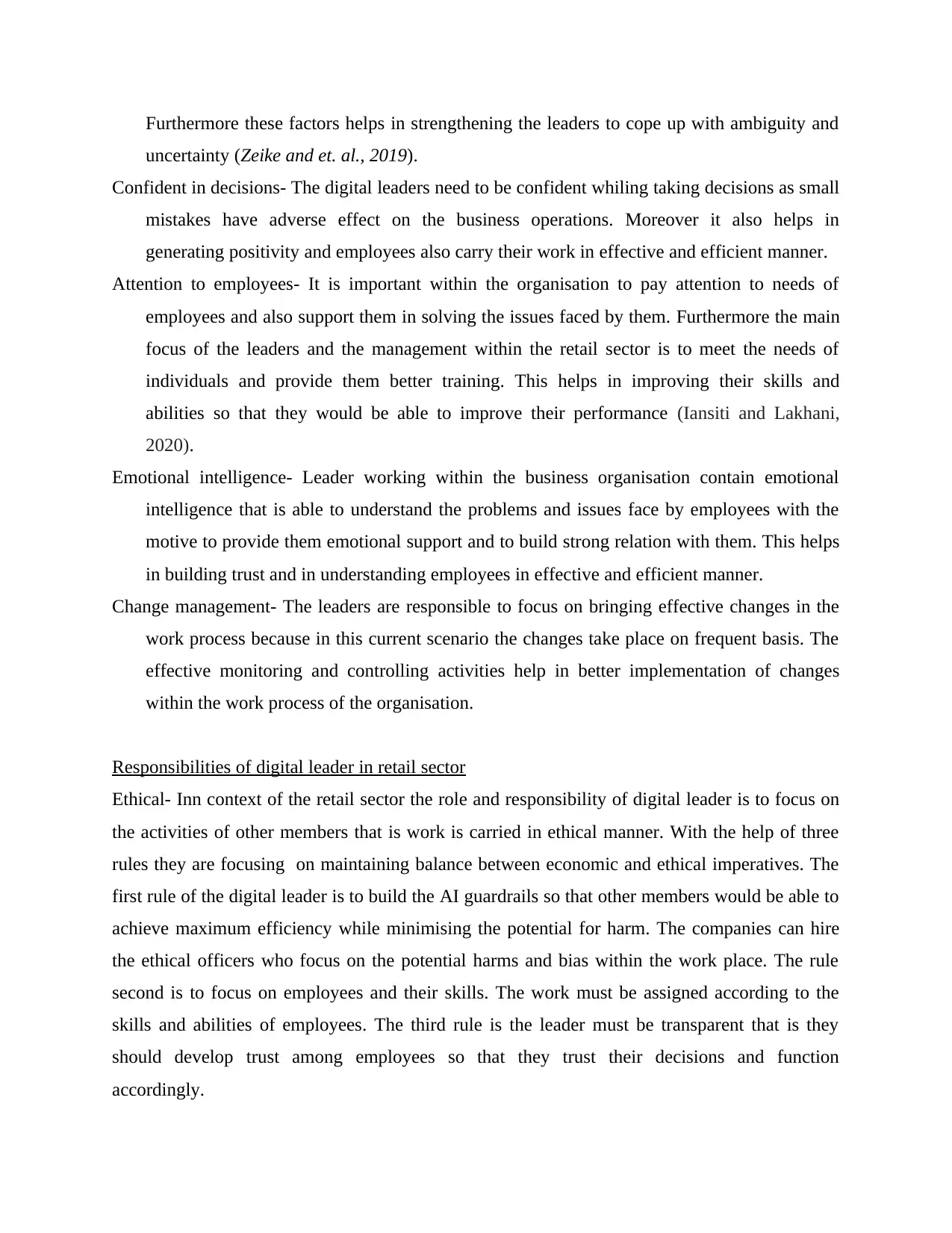
Furthermore these factors helps in strengthening the leaders to cope up with ambiguity and
uncertainty (Zeike and et. al., 2019).
Confident in decisions- The digital leaders need to be confident whiling taking decisions as small
mistakes have adverse effect on the business operations. Moreover it also helps in
generating positivity and employees also carry their work in effective and efficient manner.
Attention to employees- It is important within the organisation to pay attention to needs of
employees and also support them in solving the issues faced by them. Furthermore the main
focus of the leaders and the management within the retail sector is to meet the needs of
individuals and provide them better training. This helps in improving their skills and
abilities so that they would be able to improve their performance (Iansiti and Lakhani,
2020).
Emotional intelligence- Leader working within the business organisation contain emotional
intelligence that is able to understand the problems and issues face by employees with the
motive to provide them emotional support and to build strong relation with them. This helps
in building trust and in understanding employees in effective and efficient manner.
Change management- The leaders are responsible to focus on bringing effective changes in the
work process because in this current scenario the changes take place on frequent basis. The
effective monitoring and controlling activities help in better implementation of changes
within the work process of the organisation.
Responsibilities of digital leader in retail sector
Ethical- Inn context of the retail sector the role and responsibility of digital leader is to focus on
the activities of other members that is work is carried in ethical manner. With the help of three
rules they are focusing on maintaining balance between economic and ethical imperatives. The
first rule of the digital leader is to build the AI guardrails so that other members would be able to
achieve maximum efficiency while minimising the potential for harm. The companies can hire
the ethical officers who focus on the potential harms and bias within the work place. The rule
second is to focus on employees and their skills. The work must be assigned according to the
skills and abilities of employees. The third rule is the leader must be transparent that is they
should develop trust among employees so that they trust their decisions and function
accordingly.
uncertainty (Zeike and et. al., 2019).
Confident in decisions- The digital leaders need to be confident whiling taking decisions as small
mistakes have adverse effect on the business operations. Moreover it also helps in
generating positivity and employees also carry their work in effective and efficient manner.
Attention to employees- It is important within the organisation to pay attention to needs of
employees and also support them in solving the issues faced by them. Furthermore the main
focus of the leaders and the management within the retail sector is to meet the needs of
individuals and provide them better training. This helps in improving their skills and
abilities so that they would be able to improve their performance (Iansiti and Lakhani,
2020).
Emotional intelligence- Leader working within the business organisation contain emotional
intelligence that is able to understand the problems and issues face by employees with the
motive to provide them emotional support and to build strong relation with them. This helps
in building trust and in understanding employees in effective and efficient manner.
Change management- The leaders are responsible to focus on bringing effective changes in the
work process because in this current scenario the changes take place on frequent basis. The
effective monitoring and controlling activities help in better implementation of changes
within the work process of the organisation.
Responsibilities of digital leader in retail sector
Ethical- Inn context of the retail sector the role and responsibility of digital leader is to focus on
the activities of other members that is work is carried in ethical manner. With the help of three
rules they are focusing on maintaining balance between economic and ethical imperatives. The
first rule of the digital leader is to build the AI guardrails so that other members would be able to
achieve maximum efficiency while minimising the potential for harm. The companies can hire
the ethical officers who focus on the potential harms and bias within the work place. The rule
second is to focus on employees and their skills. The work must be assigned according to the
skills and abilities of employees. The third rule is the leader must be transparent that is they
should develop trust among employees so that they trust their decisions and function
accordingly.
⊘ This is a preview!⊘
Do you want full access?
Subscribe today to unlock all pages.

Trusted by 1+ million students worldwide
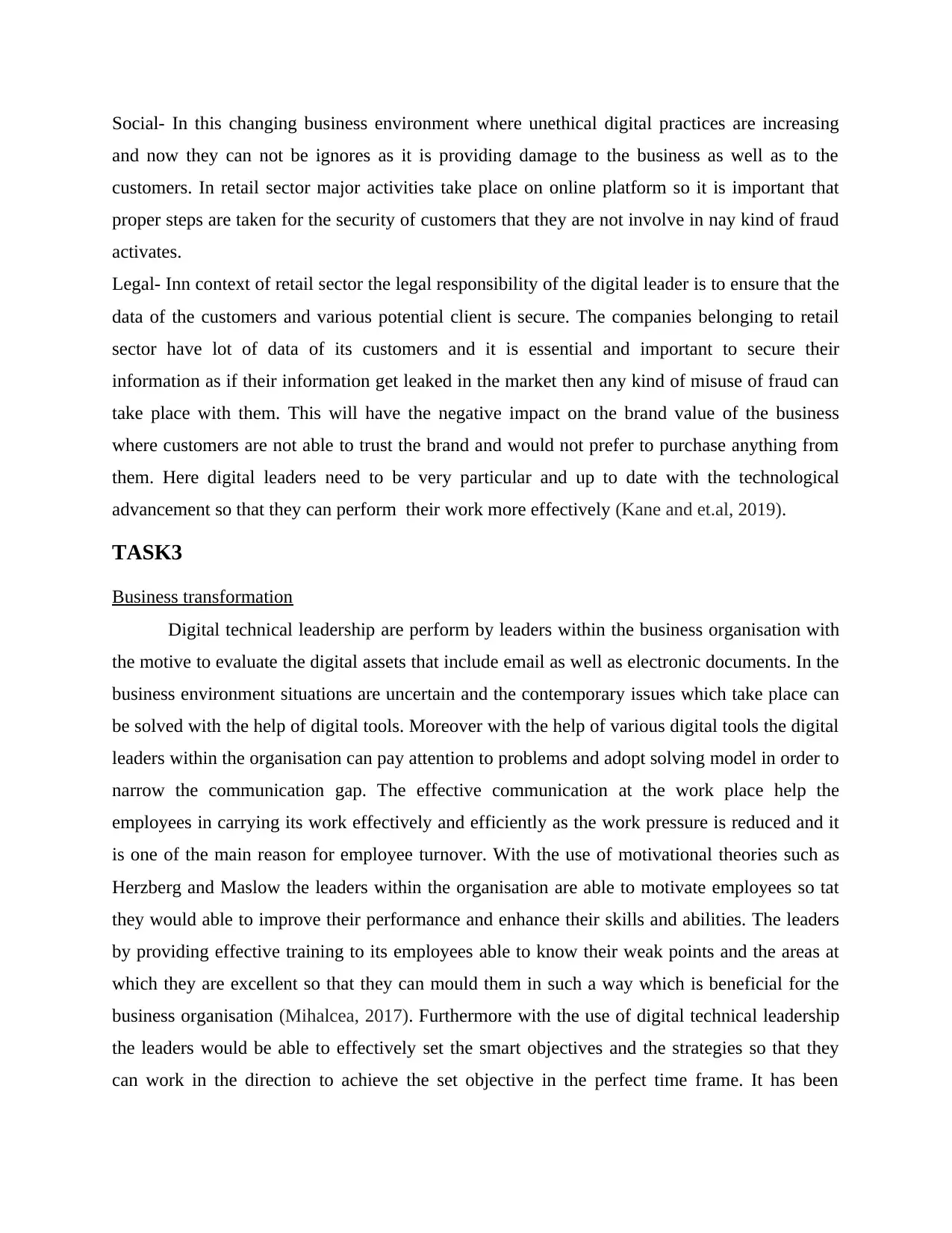
Social- In this changing business environment where unethical digital practices are increasing
and now they can not be ignores as it is providing damage to the business as well as to the
customers. In retail sector major activities take place on online platform so it is important that
proper steps are taken for the security of customers that they are not involve in nay kind of fraud
activates.
Legal- Inn context of retail sector the legal responsibility of the digital leader is to ensure that the
data of the customers and various potential client is secure. The companies belonging to retail
sector have lot of data of its customers and it is essential and important to secure their
information as if their information get leaked in the market then any kind of misuse of fraud can
take place with them. This will have the negative impact on the brand value of the business
where customers are not able to trust the brand and would not prefer to purchase anything from
them. Here digital leaders need to be very particular and up to date with the technological
advancement so that they can perform their work more effectively (Kane and et.al, 2019).
TASK3
Business transformation
Digital technical leadership are perform by leaders within the business organisation with
the motive to evaluate the digital assets that include email as well as electronic documents. In the
business environment situations are uncertain and the contemporary issues which take place can
be solved with the help of digital tools. Moreover with the help of various digital tools the digital
leaders within the organisation can pay attention to problems and adopt solving model in order to
narrow the communication gap. The effective communication at the work place help the
employees in carrying its work effectively and efficiently as the work pressure is reduced and it
is one of the main reason for employee turnover. With the use of motivational theories such as
Herzberg and Maslow the leaders within the organisation are able to motivate employees so tat
they would able to improve their performance and enhance their skills and abilities. The leaders
by providing effective training to its employees able to know their weak points and the areas at
which they are excellent so that they can mould them in such a way which is beneficial for the
business organisation (Mihalcea, 2017). Furthermore with the use of digital technical leadership
the leaders would be able to effectively set the smart objectives and the strategies so that they
can work in the direction to achieve the set objective in the perfect time frame. It has been
and now they can not be ignores as it is providing damage to the business as well as to the
customers. In retail sector major activities take place on online platform so it is important that
proper steps are taken for the security of customers that they are not involve in nay kind of fraud
activates.
Legal- Inn context of retail sector the legal responsibility of the digital leader is to ensure that the
data of the customers and various potential client is secure. The companies belonging to retail
sector have lot of data of its customers and it is essential and important to secure their
information as if their information get leaked in the market then any kind of misuse of fraud can
take place with them. This will have the negative impact on the brand value of the business
where customers are not able to trust the brand and would not prefer to purchase anything from
them. Here digital leaders need to be very particular and up to date with the technological
advancement so that they can perform their work more effectively (Kane and et.al, 2019).
TASK3
Business transformation
Digital technical leadership are perform by leaders within the business organisation with
the motive to evaluate the digital assets that include email as well as electronic documents. In the
business environment situations are uncertain and the contemporary issues which take place can
be solved with the help of digital tools. Moreover with the help of various digital tools the digital
leaders within the organisation can pay attention to problems and adopt solving model in order to
narrow the communication gap. The effective communication at the work place help the
employees in carrying its work effectively and efficiently as the work pressure is reduced and it
is one of the main reason for employee turnover. With the use of motivational theories such as
Herzberg and Maslow the leaders within the organisation are able to motivate employees so tat
they would able to improve their performance and enhance their skills and abilities. The leaders
by providing effective training to its employees able to know their weak points and the areas at
which they are excellent so that they can mould them in such a way which is beneficial for the
business organisation (Mihalcea, 2017). Furthermore with the use of digital technical leadership
the leaders would be able to effectively set the smart objectives and the strategies so that they
can work in the direction to achieve the set objective in the perfect time frame. It has been
Paraphrase This Document
Need a fresh take? Get an instant paraphrase of this document with our AI Paraphraser

evaluated that it is essential for a leader to value digital leadership as with the help of this they
can effectively facilitate proper communication, creativity and can further initiate willingness in
order to explore new ways through which Digital information and technology can be used in
order to offer more successful outcomes.
Contemporary issues indicates challenges that are faced by business. In context to retail sector,
as industry is changing rapidly due to evolution or transformation or evolution of technology.
Following is the contemporary issue that are faced by enterprise:
Declining profitability: As wide variety of options are available with customers hence,
there loyalty or recognition towards particular brand or product is reducing. Decrement in
customer attraction may lead to failure of business as there customer base will decline.
Therefore, it is required for management team of an organization to enhance promotion or
marketing activities to boost brand recognition in market. Behaviour of customers is changing
rapidly due to explosive expansion of e-commerce, as huge purchases are conducted on online
platforms. Even products are researched online prior to making purchase. It increases
comparison between products and hence, increases challenges of maintaining high quality at low
price for business. As retail sector is becoming more complex and pertains complex structures,
hence, internal communication comes up as an issue which reduces productivity of business and
decreases its activeness among customers. It is more challenging for large organizations as
several type of departments are associated with it. If internal communication system is nor
effective than processes of business will not be productive enough. It is noted that employee
turnover rate is high in retail sector which reason is that high turnover of employees increases
training and induction cost of an organization, and also recruitment of selection of new
employees in short period of time is a time consuming or effort taking process which affects
efficiency of business (Oberer and Erkollar, 2018). Due to decreasing customer base and
increasing expenditures, profitability of business is declining.
Digital technical leadership refers to strategical utilization of digital assets of company
for achievement of objectives or goals of business (Pesonen, 2020). An efficient digital leader
incorporates awareness among targets of an organization and enhances proficiency of employees
or business activities by including digital resources, service or device. Application of digital
technical leadership helps in enhancing transformation and performance of business in following
ways:
can effectively facilitate proper communication, creativity and can further initiate willingness in
order to explore new ways through which Digital information and technology can be used in
order to offer more successful outcomes.
Contemporary issues indicates challenges that are faced by business. In context to retail sector,
as industry is changing rapidly due to evolution or transformation or evolution of technology.
Following is the contemporary issue that are faced by enterprise:
Declining profitability: As wide variety of options are available with customers hence,
there loyalty or recognition towards particular brand or product is reducing. Decrement in
customer attraction may lead to failure of business as there customer base will decline.
Therefore, it is required for management team of an organization to enhance promotion or
marketing activities to boost brand recognition in market. Behaviour of customers is changing
rapidly due to explosive expansion of e-commerce, as huge purchases are conducted on online
platforms. Even products are researched online prior to making purchase. It increases
comparison between products and hence, increases challenges of maintaining high quality at low
price for business. As retail sector is becoming more complex and pertains complex structures,
hence, internal communication comes up as an issue which reduces productivity of business and
decreases its activeness among customers. It is more challenging for large organizations as
several type of departments are associated with it. If internal communication system is nor
effective than processes of business will not be productive enough. It is noted that employee
turnover rate is high in retail sector which reason is that high turnover of employees increases
training and induction cost of an organization, and also recruitment of selection of new
employees in short period of time is a time consuming or effort taking process which affects
efficiency of business (Oberer and Erkollar, 2018). Due to decreasing customer base and
increasing expenditures, profitability of business is declining.
Digital technical leadership refers to strategical utilization of digital assets of company
for achievement of objectives or goals of business (Pesonen, 2020). An efficient digital leader
incorporates awareness among targets of an organization and enhances proficiency of employees
or business activities by including digital resources, service or device. Application of digital
technical leadership helps in enhancing transformation and performance of business in following
ways:
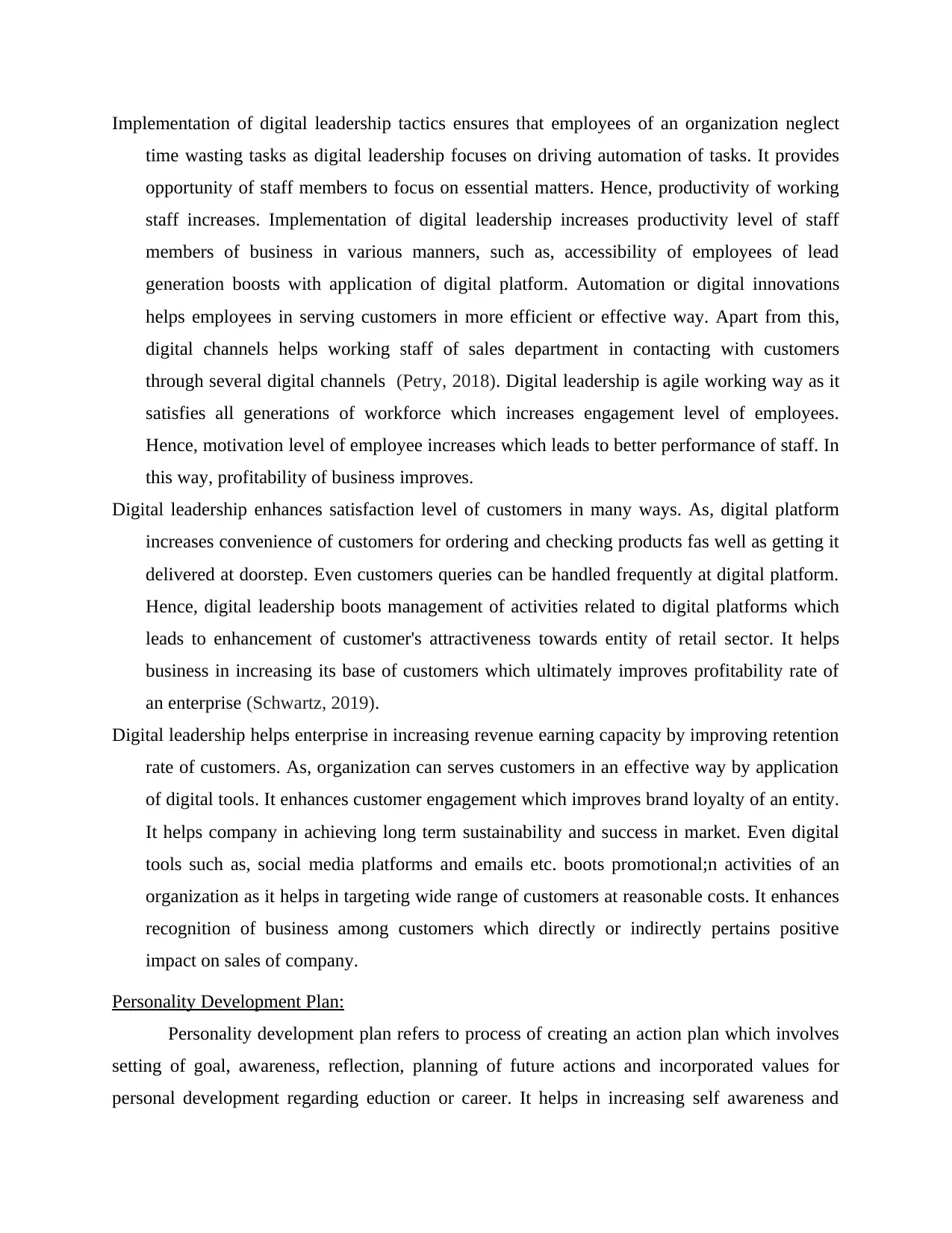
Implementation of digital leadership tactics ensures that employees of an organization neglect
time wasting tasks as digital leadership focuses on driving automation of tasks. It provides
opportunity of staff members to focus on essential matters. Hence, productivity of working
staff increases. Implementation of digital leadership increases productivity level of staff
members of business in various manners, such as, accessibility of employees of lead
generation boosts with application of digital platform. Automation or digital innovations
helps employees in serving customers in more efficient or effective way. Apart from this,
digital channels helps working staff of sales department in contacting with customers
through several digital channels (Petry, 2018). Digital leadership is agile working way as it
satisfies all generations of workforce which increases engagement level of employees.
Hence, motivation level of employee increases which leads to better performance of staff. In
this way, profitability of business improves.
Digital leadership enhances satisfaction level of customers in many ways. As, digital platform
increases convenience of customers for ordering and checking products fas well as getting it
delivered at doorstep. Even customers queries can be handled frequently at digital platform.
Hence, digital leadership boots management of activities related to digital platforms which
leads to enhancement of customer's attractiveness towards entity of retail sector. It helps
business in increasing its base of customers which ultimately improves profitability rate of
an enterprise (Schwartz, 2019).
Digital leadership helps enterprise in increasing revenue earning capacity by improving retention
rate of customers. As, organization can serves customers in an effective way by application
of digital tools. It enhances customer engagement which improves brand loyalty of an entity.
It helps company in achieving long term sustainability and success in market. Even digital
tools such as, social media platforms and emails etc. boots promotional;n activities of an
organization as it helps in targeting wide range of customers at reasonable costs. It enhances
recognition of business among customers which directly or indirectly pertains positive
impact on sales of company.
Personality Development Plan:
Personality development plan refers to process of creating an action plan which involves
setting of goal, awareness, reflection, planning of future actions and incorporated values for
personal development regarding eduction or career. It helps in increasing self awareness and
time wasting tasks as digital leadership focuses on driving automation of tasks. It provides
opportunity of staff members to focus on essential matters. Hence, productivity of working
staff increases. Implementation of digital leadership increases productivity level of staff
members of business in various manners, such as, accessibility of employees of lead
generation boosts with application of digital platform. Automation or digital innovations
helps employees in serving customers in more efficient or effective way. Apart from this,
digital channels helps working staff of sales department in contacting with customers
through several digital channels (Petry, 2018). Digital leadership is agile working way as it
satisfies all generations of workforce which increases engagement level of employees.
Hence, motivation level of employee increases which leads to better performance of staff. In
this way, profitability of business improves.
Digital leadership enhances satisfaction level of customers in many ways. As, digital platform
increases convenience of customers for ordering and checking products fas well as getting it
delivered at doorstep. Even customers queries can be handled frequently at digital platform.
Hence, digital leadership boots management of activities related to digital platforms which
leads to enhancement of customer's attractiveness towards entity of retail sector. It helps
business in increasing its base of customers which ultimately improves profitability rate of
an enterprise (Schwartz, 2019).
Digital leadership helps enterprise in increasing revenue earning capacity by improving retention
rate of customers. As, organization can serves customers in an effective way by application
of digital tools. It enhances customer engagement which improves brand loyalty of an entity.
It helps company in achieving long term sustainability and success in market. Even digital
tools such as, social media platforms and emails etc. boots promotional;n activities of an
organization as it helps in targeting wide range of customers at reasonable costs. It enhances
recognition of business among customers which directly or indirectly pertains positive
impact on sales of company.
Personality Development Plan:
Personality development plan refers to process of creating an action plan which involves
setting of goal, awareness, reflection, planning of future actions and incorporated values for
personal development regarding eduction or career. It helps in increasing self awareness and
⊘ This is a preview!⊘
Do you want full access?
Subscribe today to unlock all pages.

Trusted by 1+ million students worldwide
1 out of 18
Related Documents
Your All-in-One AI-Powered Toolkit for Academic Success.
+13062052269
info@desklib.com
Available 24*7 on WhatsApp / Email
![[object Object]](/_next/static/media/star-bottom.7253800d.svg)
Unlock your academic potential
Copyright © 2020–2026 A2Z Services. All Rights Reserved. Developed and managed by ZUCOL.





